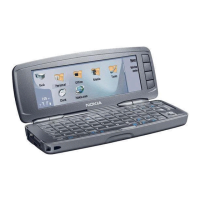secondary DNS (domain name server) addresses are
obtained automatically from the server. DNS is an
Internet service that translates domain names such as
www.nokia.com into IPv4 addresses such as
192.100.124.195, or IPv6 addresses like
3ffe:2650:a640:1c2:341:c39:14. If you select No for the
IPv4 protocol, or Manual for the IPv6 protocol, you
must specify the IP addresses for the primary and
secondary DNS servers.
Proxies page
You may want to use a proxy to quicken access to the
Internet. Note also that some Internet service providers
require the use of Web proxies. Contact your Internet
service provider to determine proxy details.
If you have made an Internet connection to your
company’s intranet, and are unable to retrieve Web pages
from the general Internet, you may need to setup a proxy
server to retrieve Web pages outside your company’s
intranet.
Define the following:
• Proxy protocol — Select the protocol type of the proxy.
You can set different proxy settings for each protocol.
• Use proxy server — Select Yes to use the proxy server.
• Proxy server — Enter the IP address of the proxy
server, or the domain name. Example domain names
are: company.com and organisation.org.
• Port number — The number of the proxy port. The port
number is related to the protocol. Common values are
8000 and 8080, but vary with every proxy server.
• No proxy for — Define the domains for which the HTTP
or HTTPS proxy is not needed.
WPA/WPA2 page
You can specify WPA (Wi-Fi protected access) and WPA2
(Wi-Fi protected access 2) authentication settings. The
network must support this feature and corresponding
values must be entered in the wireless LAN access point.
• Authentication mode — Select EAP if you want to use
an EAP module for authentication. If you select Pre-
shared key, type the password (also called a master
key) in the field below. Note that the same key must
be entered in the wireless LAN access point.
• Use WPA2 only — If you select Yes, the device uses only
WPA2 security with this Internet access point.
EAP page
You can configure various EAP (extensible authentication
protocol) modules that are used for authentication and
data encryption. Note that corresponding values must be
entered in the wireless LAN access point. EAP
authentication is only available if you have selected WPA/
WPA2 or 802.1x as the security mode.
For instructions on editing the EAP module settings, see
the Help function in the device.
WEP page
You can create up to four WEP keys. Corresponding values
must be entered in the wireless LAN access point.
• WEP authentication — Select Open or Shared as a
means of authentication between the wireless device
and the wireless LAN access point.
• WEP key in use — Select the WEP key you want to use
with the Internet access point you are creating.
• Key #1 length — Select the appropriate key length.
The more bits there are in the key, the higher the level
of security. WEP keys consist of a secret key and a 24-
93
Control panel
Cyan

